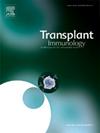Identification of genes associated with liver ischemia-reperfusion injury after liver transplantation by WGCNA and PPI network analyses
IF 1.4
4区 医学
Q4 IMMUNOLOGY
引用次数: 0
Abstract
Liver transplantation is the only effective treatment for end-stage liver disease. The success of transplantation largely relies on liver ischemia/reperfusion injury (LIRI). However, the pathogenesis of LIRI remains unclear. In this study, we used the public dataset GSE12720, which contains liver transplants from both living and deceased donors, to identify differentially expressed genes (DEGs) before and after reperfusion. Weighted gene co-expression network analysis (WGCNA) was used to identify related genes. A protein–protein interaction network containing 85 overlapping DEGs and WGCNA genes was constructed. Using Molecular Complex Detection and cytoHubba plug-ins in Cytoscape and Kyoto Encyclopedia of Genes and Genomes analyses, we identified 5 core pathways and 13 hub genes (IL-1β, JUN, TNFAIP3, CCL2, ICAM1, CCL20, SOCS3, IRF1, BIRC3, GADD45B, MYC, CCL4, and BCL2A1). These findings were validated using two independent datasets (GSE14951 and GSE15480) and a mouse LIRI model, which effectively confirmed the expression levels of 13 hub genes. This study aimed to use advanced bioinformatics methods to investigate hub genes related to LIRI to identify new biomarkers and improve our understanding of LIRI pathogenesis.
应用WGCNA和PPI网络分析鉴定肝移植后肝缺血再灌注损伤相关基因。
肝移植是终末期肝病唯一有效的治疗方法。移植的成功很大程度上依赖于肝脏缺血/再灌注损伤(LIRI)。然而,LIRI的发病机制尚不清楚。在这项研究中,我们使用公共数据集GSE12720,其中包含来自活体和已故供体的肝移植,以鉴定再灌注前后的差异表达基因(deg)。加权基因共表达网络分析(Weighted gene co-expression network analysis, WGCNA)鉴定相关基因。构建了包含85个重叠的DEGs和WGCNA基因的蛋白相互作用网络。利用Cytoscape和京都基因与基因组百科分析中的分子复合物检测和细胞hubba插件,我们确定了5个核心通路和13个枢纽基因(IL-1β、JUN、TNFAIP3、CCL2、ICAM1、CCL20、SOCS3、IRF1、BIRC3、GADD45B、MYC、CCL4和BCL2A1)。使用两个独立的数据集(GSE14951和GSE15480)和小鼠LIRI模型验证了这些发现,有效地确认了13个枢纽基因的表达水平。本研究旨在利用先进的生物信息学方法研究与LIRI相关的枢纽基因,以发现新的生物标志物,提高我们对LIRI发病机制的认识。
本文章由计算机程序翻译,如有差异,请以英文原文为准。
求助全文
约1分钟内获得全文
求助全文
来源期刊

Transplant immunology
医学-免疫学
CiteScore
2.10
自引率
13.30%
发文量
198
审稿时长
48 days
期刊介绍:
Transplant Immunology will publish up-to-date information on all aspects of the broad field it encompasses. The journal will be directed at (basic) scientists, tissue typers, transplant physicians and surgeons, and research and data on all immunological aspects of organ-, tissue- and (haematopoietic) stem cell transplantation are of potential interest to the readers of Transplant Immunology. Original papers, Review articles and Hypotheses will be considered for publication and submitted manuscripts will be rapidly peer-reviewed and published. They will be judged on the basis of scientific merit, originality, timeliness and quality.
 求助内容:
求助内容: 应助结果提醒方式:
应助结果提醒方式:


